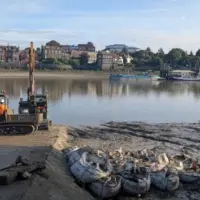
(LONDON) — Heavy machinery is tearing through what locals are calling “wet wipe island,” an 820-foot shoreline of flushed bathroom debris that has transformed a stretch of London’s Thames River into an environmental nightmare.
The clean-up near Hammersmith Bridge in West London represents the United Kingdom’s first attempt to mechanically remove wet wipes from a river and, over the next month, excavators will extract an estimated 180 tons of congealed waste — equivalent to the weight of 15 double-decker buses spread across an area the size of two tennis courts.
“We’re doing the first mass removal of wet wipes that’s ever taken place in the country,” Emily McLean, senior technical advisor for the Port of London Authority, which is coordinating the operation, told ABC News.
The mechanical intervention comes after nearly a decade of volunteers painstakingly collecting wet wipes by hand. Thames21, an environmental charity, has documented the problem since 2017, with volunteers removing 140,000 individual wipes while mapping the contamination’s spread.
“It’s a validation of eight years of work,” said Ann Willard Sullivan, a Thames21 volunteer who leads cleanup efforts in the area. “It’s a sign that there can be big change, don’t give up.”
The volunteer data proved crucial in convincing authorities to act and, what started as citizen science, became the foundation for both this cleanup and potential broader policy changes down the line.
The Thames’ 23-foot tidal range creates a narrow window for the cleanup work meaning excavators can only operate during a four-hour window around low tide when the debris becomes accessible.
McLean said that engineers are using a “rake and shake” method to separate wet wipes from river sediment, ensuring that essential materials for the Thames ecosystem remain on the riverbed while removing only the contamination.
“We’re removing that contaminated layer while retaining as much of the foreshore as we can,” explained Grace Rawnsley, sustainability director for the Port of London Authority.
The cleanup represents the latest chapter in the clean-up of the Thames after it was declared “biologically dead” by the Natural History Museum in 1957.
“This is a huge moment — after years of campaigning, wet wipe island hopefully is no more!” said Fleur Anderson, the MP for Putney, Southfields, Roehampton and Wandsworth Town. “The ban I’ve introduced will mean 3.8 billion wipes removed from the network every year. A win for our waters, sewers and environment!”
Now, nearly 70 years later, it supports 125 different fish species and serves as a nursery for five types of sharks, according to the Zoological Society of London.
Wet wipes, however, have recently threatened this recovery, with the plastic-laden debris breaking down into microplastics that clog digestive systems of fish and disrupt feeding patterns, according to the World Wide Fund for Nature.
Recent scientific research indicates that an estimated 70% of Thames flounder contain plastic fibers in their stomachs.
“They get stuck in fish stomachs,” McLean said. “So, we really think that by removing them, we’re taking out those contaminants, and that will help the water quality.”
The Hammersmith cleanup coincides with Britain’s groundbreaking approach to wet wipe pollution when, in April 2024, the U.K. government announced plans to ban plastic-containing wet wipes, with implementation expected by 2026.
The legislation followed massive public support, with 95% of respondents to a recent survey backing the ban.
Currently, Britons use approximately 11 billion wet wipes annually, with an estimated 2.5 billion flushed down toilets, according to Thames21.
Thames Water says that it spends £18 million ($24 million) yearly removing 3.8 billion wipes from London’s sewage system alone, costs that are ultimately passed to consumers through higher water bills.
The wet wipe issue extends far beyond the Thames, however, with water companies across the U.K. collectively spend £100 million ($135 million) annually clearing 300,000 sewer blockages, with 93% caused by flushed wipes, according to an October 2021 research report from United Utilities.
“These wet wipes should never be entering into the river,” Felicity Rhodes, Thames program manager at Thames21, told ABC News.
The charity advocates for a “multi-stakeholder approach” involving manufacturers, water companies, government regulation and consumer behavior change.
The Port of London Authority estimates the monthlong operation will cost “hundreds of thousands” of pounds, a fraction of the ongoing costs of wet wipe pollution.
For the rowers gliding past the cleanup site, the mechanical intervention represents both an end and a beginning: the removal of London’s most embarrassing landmark and a step toward the Thames that millions of Londoners want their river to become.
ABC News’ Maggie Rulli and Charlotte Gardiner contributed to this report.
Copyright © 2025, ABC Audio. All rights reserved.













